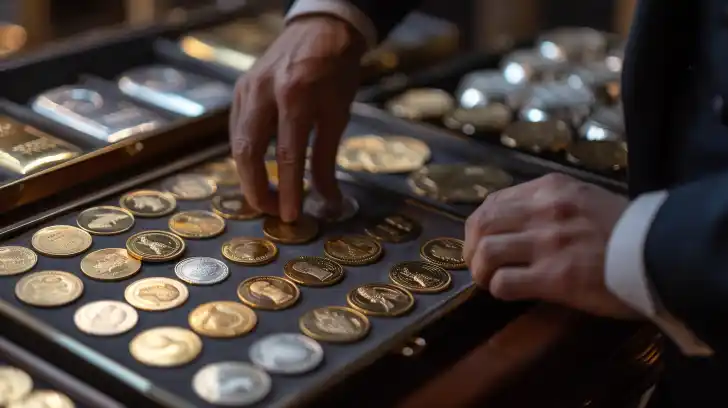Gold & Silver Investments: Your Foolproof Strategy for Financial Security
Published on
15 minute read

Are you worried about the future of your finances? Gold and silver have been reliable stores of value for centuries. This blog post will guide you through a proven strategy for investing in precious metals to safeguard your wealth.
Key Takeaways
- Gold and silver act as portfolio diversifiers and safe-haven assets during economic crises, protecting wealth from market volatility and inflation. Allocating 5-10% of a portfolio to precious metals can enhance long-term returns.
- Investing in physical bullion, coins, exchange – traded funds (ETFs), mining stocks, and digital representations offer various ways to gain exposure to gold and silver markets. Each method has its advantages and considerations.
- Factors like central bank policies, geopolitical events, and macroeconomic conditions significantly influence the demand and prices of precious metals. Monitoring these factors is crucial for strategic investment decisions.
- Diversification strategies like dollar-cost averaging and building a balanced portfolio with different precious metals assets can mitigate risks and provide long-term growth potential.
- Consulting tax professionals and understanding legal regulations are essential for tax – efficient precious metals investing and ensuring compliance with reporting requirements.
The Role of Gold and Silver in a Portfolio
Gold and silver act as portfolio diversifiers. These precious metals offer a safe haven in times of crisis.
Gold as a Portfolio Diversifier
Diversifying investments mitigates risk. Gold adds diversity to a portfolio. It has low correlations with other asset classes like stocks and bonds. This makes gold a valuable hedge against market volatility.
Gold holds its value during economic downturns. It retains purchasing power when currencies lose value. Investing in gold balances risk exposure from inflation and currency fluctuations.
Owning physical gold or gold-related securities safeguards wealth.
The finite supply of gold underpins its value. Central banks hold gold reserves as insurance. Gold exchange-traded funds (ETFs) and mining stocks allow investors exposure to precious metals markets.

A Safe Haven in a Crisis
Gold and silver provide a safe haven during crises. They retain value when other assets decline. Investors seek precious metals to protect wealth in turbulent times.
Historically, gold prices rise amid economic turmoil, political unrest, and currency devaluation. Silver follows gold’s upward trajectory. This makes them a crisis hedge against stock market crashes and hyperinflation.
Precious metals act as portfolio diversifiers, reducing overall risk. They exhibit low correlation with other asset classes like equities and bonds. Their countercyclical nature safeguards investments when traditional holdings falter.
Building Generational Wealth
Precious metals like gold and silver serve as effective tools for building generational wealth. Their scarcity and intrinsic value provide an edge against economic turmoil, allowing families to preserve assets across generations.
Physical bullion or coin ownership facilitates seamless wealth transfer, shielding wealth from market uncertainties. [Goldsilver.com], [Wealthcycles.com] and [The Great Depression] showcase the role of these metals in financial security.
Savvy investors incorporate gold and silver into diverse portfolios as hedges against inflation. Their historical reputation, coupled with central banks’ substantial holdings, underscores their significance in long-term wealth strategies.
Understanding Inflation and Its Impact on Precious Metals
Inflation erodes the purchasing power of money. Gold and silver act as a hedge against inflation. When prices rise, precious metals tend to increase in value.
Precious metals like gold and silver preserve wealth over the long term. Central bank policies influence inflation rates. This impacts the demand for precious metals as a store of value.
How Gold and Silver Have Preserved Wealth in Times of Inflation
Gold effectively preserves wealth during inflationary periods. It maintains purchasing power when fiat currencies decline. Historical data shows gold’s price rises alongside the Consumer Price Index (CPI).
Silver also safeguards against inflation but is more volatile, benefiting from economic expansions.
Gold and silver offset inflationary pressures stemming from excessive money supply growth. Central banks’ loose monetary policies devalue currencies, driving precious metals’ prices higher.
These tangible assets provide a hedge against currency debasement.
Furthermore, geopolitical tensions and economic uncertainties elevate gold and silver’s role as crisis havens. Their scarcity enhances their status as stores of value when faith in paper money erodes.

Macroeconomic Factors Affecting Precious Metals’ Values
Precious metals’ values heavily rely on macroeconomic factors. Inflation impacts gold and silver prices. High inflation increases their appeal as inflation hedges. But low inflation dampens demand.
Central banks’ monetary policies influence money supply. Easy money boosts precious metals. Similarly, geopolitical tensions drive investors to safe havens like gold. Currencies’ strength versus the U.S. dollar affects precious metals traded globally in dollars.
Economic growth impacts precious metals. Robust growth reduces their appeal as safe havens. But growth fears increase their demand. Interest rates impact opportunity costs of holding non-yielding bullion.
Higher rates make other interest-bearing assets more attractive. Conversely, lower rates boost precious metals. Energy prices also influence precious metals mining costs and production levels.
Central Bank Policies and Their Influence on Gold and Silver Markets
Central banks hold significant sway over precious metal markets. Their policies impact gold and silver prices. Purchases increase demand, driving up costs. Sales reduce demand, lowering prices.
Quantitative easing expands money supply, decreasing currency value, increasing gold’s appeal as a hedge. Interest rate adjustments affect investment alternatives, influencing precious metal demand.
Foreign exchange interventions alter currency valuations, affecting import/export costs, impacting mining profitability. Central banks monitor economic conditions, adjusting policies accordingly, creating price fluctuations.
Central banks’ activities shape supply/demand dynamics for physical bullion. Substantial transactions impact availability, distribution, premiums charged by dealers and mints. Transparency on gold reserves influences market sentiment.
Geopolitical Events and Their Impact on Precious Metals
Geopolitical tensions create economic uncertainty. Investors flock to precious metals like gold and silver as safe-haven assets. Wars, conflicts and political instability increase demand for precious metals.
Their prices surge as investors seek wealth protection.
Global superpowers stockpile bullion reserves during crises. Central banks hoard gold to hedge against currency devaluation risks. Geopolitical hotspots influence investment flows into the precious metals sector.
Investing in Gold and Silver: Different Methods
There are various ways to invest in gold and silver. Physical assets like coins and bars offer tangible ownership. Exchange-traded funds (ETFs) provide exposure without physical possession.
Physical Gold and Silver Coins/Bullion
Physical gold and silver refer to precious metals in their raw form. Bullion represents gold or silver bars and ingots with a high purity level of at least 99.5%.
- Tangibility: Physical ownership of gold or silver provides a tangible asset, unlike intangible assets like stocks or bonds.
- Liquidity: Bullion can be easily converted into cash, making it a highly liquid investment.
- Diversification: Adding physical precious metals to a portfolio can help diversify risk and protect against market volatility.
- Hedge against inflation: Historically, gold and silver have maintained their purchasing power during inflationary periods.
- No third-party risk: Unlike paper assets, physical bullion is not subject to counterparty or default risks.
- Long-term value retention: Precious metals have been valued for centuries and are expected to retain their worth.
- Storage and insurance costs: Owning physical bullion requires secure storage and insurance, adding additional expenses.
- Difficulty in selling: Selling physical bullion may require locating reputable dealers, unlike trading electronic assets.
- Lack of dividends or income: Physical precious metals do not generate income like stocks or bonds.
- Tax implications: Profits from selling bullion may be subject to capital gains taxes, depending on individual circumstances.
- Potential for theft or loss: Physical assets can be stolen or misplaced, unlike digital assets.
Gold and Silver ETFs and Options
Gold and silver offer investment options through ETFs and options. ETFs track precious metals’ prices.
- ETFs provide exposure to gold and silver without physical possession.
- Gold ETFs mirror gold bullion’s performance.
- Silver ETFs mimic silver spot price movements.
- Precious metals ETFs invest in companies involved in mining and exploration.
- Options contracts give the right to buy or sell gold/silver futures at agreed prices and dates.
- Call options allow purchasing gold/silver futures at strike prices.
- Put options enable selling gold/silver futures contracts at strike prices.
- Options strategies like spreads and combinations manage risk and leverage.
- ETFs and options provide liquidity and diversification in precious metals investing.
- They offer convenient ways to gain exposure to gold and silver price fluctuations.
Miners and Royalty/Streaming Companies
Royalty and streaming companies finance mines rather than operating them themselves. Precious metals, particularly gold and silver, account for more than 90% of streamed deals in the mining industry.
Investing in royalty and streaming companies provides diversification within the gold sector. It spreads risk across multiple mines and projects. These companies offer a different method of investing in gold and silver compared to traditional mining operations. They provide potential benefits for investors:
- Lower Operational Costs: Royalty and streaming firms do not bear the costs of digging, extraction, or day-to-day operations. Their expenses relate to financing activities.
- Portfolio Diversification: A single royalty/streaming company may have interests in numerous mines across various regions and commodities. This diversifies revenue sources.
- Upfront Payments: These entities provide upfront capital to miners in exchange for future metal deliveries or royalties on revenue. This offers financing flexibility.
- Predictable Cash Flows: Royalty/streaming agreements guarantee a percentage of revenue or production at predetermined prices. Cash flows are more predictable.
- Tax Benefits: Some jurisdictions offer tax incentives for financing activities rather than direct mining operations.
Popular royalty and streaming companies include Franco-Nevada, Wheaton Precious Metals, and Royal Gold. Investors gain exposure to precious metals without the risks of direct mining.
Digital Representations of Gold and Silver
Technological advancements revolutionized precious metal investments. Digital representations offer unique benefits.
- Accessibility: Online platforms enable investors to purchase fractions of gold or silver bullion conveniently.
- Lower costs: Digital assets eliminate storage, transportation, and insurance expenses associated with physical metals.
- Transparency: Blockchain technology provides an immutable record of ownership and transactions.
- Liquidity: Digital precious metals can be easily bought or sold on global exchanges.
- Security: Assets are stored in secure digital vaults, minimizing theft or loss risks.
- Flexibility: Investors can convert digital holdings into physical bullion or fiat currencies.
- Divisibility: Digital tokens represent small, divisible units, facilitating smaller investments.
- Utility: Some digital currencies are backed by physical gold or silver reserves.
- Portability: Digital wallets allow seamless transfer or storage of assets across borders.
- Traceability: The provenance of digitized precious metals is verifiable through tamper-proof records.
Diversification and Investment Strategies
Diversifying your investments with precious metals like gold and silver can provide stability and long-term growth. Consider dollar-cost averaging, which involves regularly investing fixed amounts regardless of market fluctuations.
Combining physical bullion, ETFs, and mining stocks can create a balanced precious metals portfolio. Review the concepts and tools related to diversification strategies to make informed choices about safeguarding your financial future.
Building a Balanced Portfolio with Precious Metals
Including precious metals in an investment portfolio provides diversification benefits. Owning assets like gold and silver reduces overall portfolio risk. Their value tends to move inversely to stocks and bonds.
This diversification improves returns during market volatility.
A balanced portfolio strategy includes allocating 5-10% to precious metals like gold bullion, silver coins, or mining stocks. Rebalance annually to maintain target allocation percentages.
Long-Term vs. Short-Term Strategies
Long-term investors seek to build wealth gradually over time. They invest in assets with potential for steady growth, like precious metals. Gold and silver offer portfolio diversification, shielding from market volatility.
Short-term traders hunt quick profits through frequent buying and selling. Their strategies depend on market timing and price swings. A measured approach suits most individual investors pursuing financial security.
Dollar-Cost Averaging and Other Investment Approaches
Dollar-cost averaging offers you a disciplined approach. It involves regularly investing a fixed amount in precious metals at predetermined intervals. This investment strategy eliminates the need to time the market.
Key Benefits:
- Minimizes Risk: You buy assets at varying prices, reducing the impact of volatility.
- Consistent Investing: Regular investments help you build a position over time.
- Removes Emotions: Emotions often lead to poor investment decisions. This strategy eliminates emotional biases.
- Lower Entry Point: You potentially achieve a lower average cost per unit.
Other Investment Approaches:
- Value Investing: You seek undervalued assets trading below their intrinsic worth. This involves rigorous research and analysis.
- Growth Investing: You invest in companies with above-average growth potential. You aim to capitalize on their future earnings.
- Income Investing: You prioritize assets that generate regular income streams like dividends or interest payments.
Diversification is crucial for mitigating risks. A blend of strategies aligned with your goals and risk tolerance is advisable. Precious metals investments can play a pivotal role in a well-diversified portfolio.
Legal and Tax Considerations for Gold and Silver Investments
Legal and tax matters require careful consideration when investing in gold and silver. Regulations and reporting obligations vary across jurisdictions.
Seeking professional guidance on taxation and compliance proves beneficial for investors. Tax planning strategies help maximize returns from precious metals investments.
Reporting and Taxation of Precious Metal Investments
Precious metals investments carry specific tax rules. Physical gold and silver holdings outside retirement accounts face collectibles tax of 28% on long-term capital gains. Accurately reporting cost basis and gains is crucial for tax compliance.
Exchange-traded funds (ETFs) backed by precious metals are also treated as collectibles for taxation. Investors must understand the tax implications to minimize liabilities through strategies like offsetting capital gains.
Consulting tax professionals can help navigate the tax landscape for gold and silver investments.
Regulatory Guidelines and Compliance
Investors must comply with regulatory guidelines for precious metals. Financial authorities oversee transactions to combat illegal activities. Gold and silver investing requires understanding tax laws and reporting requirements.
Reputable dealers follow anti-money laundering rules. Consulting tax professionals ensures investments align with regulations.
Seeking Professional Advice for Tax Planning
Gold and silver investments carry tax implications. Consulting tax advisors ensures legal compliance. They guide on reporting precious metal gains and losses. Tax experts know deductions and exemptions relevant to your situation.
Their advice optimizes tax efficiency for gold and silver holdings.
Professional financial advisors clarify the tax treatment of different investment vehicles like physical bullion, ETFs, or mining stocks. They tailor strategies to your financial goals and risk appetite.
The Psychology of Investing in Precious Metals
Investing in precious metals during inflationary times tests an investor’s emotional resilience. Keeping emotions in check and making rational decisions based on sound analysis is key.
Investing in Precious Metals During Inflationary Times
Precious metals offer stability during inflationary periods. Investors seek gold and silver to protect wealth from currency devaluation. As fiat money supply increases, demand for finite precious metals rises.
Gold historically preserves purchasing power. Silver offers affordability for modest investments. Diversifying with metals provides a hedge against economic crises. Monetary policies and geopolitical tensions influence precious metal values.
Adding bullion coins or ETFs reduces portfolio volatility. For generational wealth preservation, consider dollar-cost averaging into gold and silver.
Common Emotional Pitfalls to Avoid
Investing in precious metals like gold and silver requires emotional discipline. Here are some common pitfalls to avoid:
- Fear of missing out. The prices of gold and silver fluctuate. Investors may feel pressure to buy during upswings, fearing they’ll miss potential gains. Conversely, they sell during downturns out of panic.
- Greed. Investors chase higher returns, expecting unrealistic profits from precious metals. This greed often leads to poor decisions like over-allocating portfolios or trading frequently.
- Overconfidence bias. Some investors wrongly believe they can time bullion markets perfectly based on news or personal analysis. This false confidence results in losses.
- Anchoring bias. Investors become fixated on an arbitrary price point for buying or selling, ignoring market realities. This inflexibility hinders good decision-making.
- Herd mentality. Following the crowd’s investment patterns without independent analysis is dangerous. Groupthink causes irrational exuberance or undue pessimism.
- Recency bias. Giving excessive weight to recent price trends and ignoring long-term patterns is a pitfall. Precious metals require a multi-year outlook.
- Confirmation bias. Investors favor information confirming their existing beliefs about gold/silver while ignoring contradictory data. Objectivity is crucial.
Emotional discipline, rational analysis of market fundamentals, and adherence to a well-designed investment strategy are vital for successful precious metals investing.
Staying Informed and Disciplined in Investment Decisions
Investors must stay informed about precious metals markets. They should study economic indicators, government policies, and global events affecting gold and silver. Reading expert analysis and joining online communities helps gain knowledge.
Discipline prevents emotional decisions hurting returns. Set investing goals, risk tolerance, and stick to strategies. Review portfolios regularly but avoid reacting impulsively to short-term fluctuations.
Patience during downturns is key.
Successful precious metals investing requires ongoing research into factors like inflation, currency movements, and mining production. Subscribing to reputable newsletters and following respected analysts provides valuable insights.
A disciplined approach means having an investment plan, diversifying across asset types, and rebalancing periodically. Emotional reactions like buying at market peaks or panic selling during dips can derail long-term strategies.
Conclusion
Take action today. Secure your financial future with precious metals. Gold and silver investments offer generational wealth protection against inflation and economic uncertainty. Diversify wisely with bullion, ETFs, or miners for a balanced portfolio.
Consult professionals to navigate tax implications. Stay disciplined in your strategy – your path to financial security awaits.
Recap of Key Strategies for Wealth Protection
Precious metals offer a crucial hedge against inflation. Gold and silver preserve purchasing power during economic turmoil. Diversifying portfolios with physical bullion and mining stocks safeguards wealth.
A balanced asset allocation incorporates alternative investments like gold ETFs. Dollar-cost averaging reduces risk through systematic investing. Seeking professional guidance ensures tax-efficient precious metals strategies.
Emotional discipline avoids rash decisions that jeopardize long-term objectives.
Encouragement to Take Informed Action
Taking informed action safeguards your wealth. Diversify your portfolio by investing in time-tested precious metals like gold and silver. These assets preserve purchasing power during inflationary periods and economic instability.
Research reputable dealers, exchanges, and financial advisors to guide your investment decisions. Stay disciplined and avoid emotional pitfalls. Protect your hard-earned money through precious metals investing.
Professional guidance facilitates wise investment choices. Consult experts to determine suitable precious metals allocations within your retirement accounts and overall portfolio. Develop strategies aligned with your financial objectives and risk tolerance.
Final Thoughts on the Value of Precious Metals
Precious metals provide a reliable hedge against inflation. Gold and silver have intrinsic value. Economic turmoil highlights their importance in safeguarding wealth. They act as a store of value during financial crises.
Prudent investors allocate a portion of their portfolio to precious metals. This strategy preserves purchasing power over time.
Physical bullion offers tangibility and liquidity. Gold ETFs (Exchange-Traded Funds) offer convenient exposure. Mining stocks provide leveraged upside potential. Investors should consider the role of precious metals.
For a deeper dive into forecasted financial trends, explore why bankers predict CDs will outshine high-interest savings accounts in 2024.
FAQs
1. What is the gold standard?
The gold standard refers to a monetary system where a country’s currency is pegged to gold, allowing conversion of paper money into a fixed amount of gold.
2. Why should I invest in gold and silver?
Investing in gold and silver can provide a hedge against economic cycles, recessions, and financial crises. They tend to rise when the supply of money increases or the dollar devalues.
3. How can I buy gold and silver?
You can buy physical gold and silver from bullion dealers or invest in gold mining stocks, mutual funds, and exchange-traded funds (ETFs) that track the spot price of gold.
4. Is it better to invest in gold or silver?
Both gold and silver have their advantages. Gold is considered a more stable investment, while silver is more volatile but offers higher potential returns.
5. How much of my retirement portfolio should be in gold and silver?
There is no one-size-fits-all answer, but many financial advisors recommend allocating 5-10% of your portfolio to precious metals like gold and silver for diversification.
6. What factors influence the price of gold and silver?
The price of gold and silver is influenced by various factors, including supply and demand, the strength of the U.S. dollar, interest rates, inflation, and macroeconomic conditions.
Source Links
- https://finance.yahoo.com/news/m-investing-expert-why-buying-220010779.html
- https://rejoycefinancial.com/gold-silver-financial-goals
- https://www.cbsnews.com/news/gold-and-silver-investing-everything-to-know
- https://www.lynalden.com/precious-metals-investing
- https://www.morganstanley.com/articles/investing-gold-silver-decision-guide
- https://www.investopedia.com/how-to-invest-in-gold-and-silver-7369625





